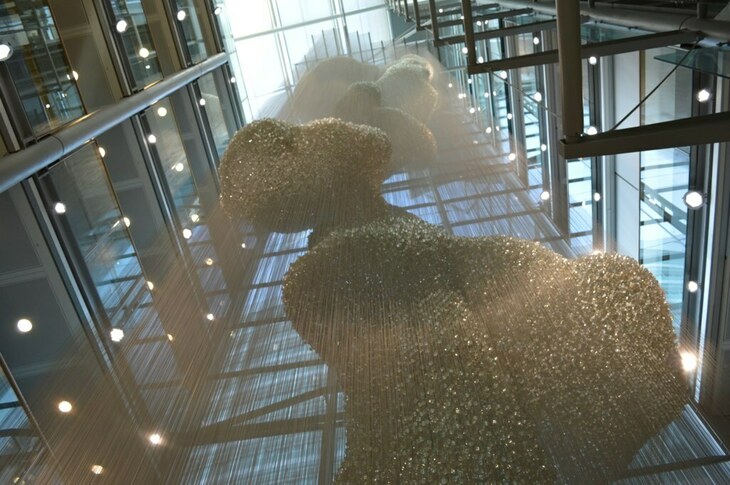Michael Hopkins — who died on on 17 June 2023 — may not have had the starchitect status of, say, Richard Rogers or Zaha Hadid, but he was the brains behind some awe-inspiring (and controversial) London buildings. Here are five of his practice's best.
Westminster Underground station

"Like entering the lair of a Bond villain" is how we described Westminster station — and we mean that in the best possible way. A gaping brutalist grotto with elephant legs for columns, and escalators zig zagging this way and that — there is a sense that you're venturing somewhere you shouldn't be.
"Who could fail to be transfixed by the cathedral-like proportions of this underground station which uses these qualities to such great effect, as has been achieved before by so many of the world's best architects — Wren, Piranesi, Pisano?..." gushed interior designer Philippa Thorp, shortly after Westminster station opened in 2001. It made tube stations exciting again, and over two decades on, still provides a thrill every time you descend into this gunmetal underworld.
Portcullis House, Westminster

The upstairs neighbour of Westminster station — and usually off-limits to the hoi polloi — it's a pity so few get to so much as stick their heads inside Portcullis House. Let's just hope the MPs who use it as a spiffy meeting/break room appreciate its peach of a diamond-latticed atrium, forming a gorgeous winter garden sprinkled with swish restaurants — not to mention a nifty underground passage for nipping into the Houses of Parliament without have to face Joe Public.
The rest of us have to make do with the strange be-chimneyed exterior — inspired, apparently by the Victorian Gothic of Parliament across the way; a seriously divisive design mash up of Charles Barry and steampunk. We still can't make out if we like it or not. (Although Londonist's editor-at-large Matt Brown admits to having a 'secret crush' on the building.)
Lee Valley VeloPark, Stratford

You can um and ah about London 2012's legacy all you want, but the Games certainly left Stratford with some world-beating structures. Is it a beret? Is it a massive Pringle? Who cares, the Lee Valley VeloPark as it's now called, is a stunner — designed to mirror the movement of the bikes on the track inside. Maybe these formidable surroundings even inspired the slew of wins beneath its roof, from Team GB. The velodrome was rightly put up for the 2011 RIBA Stirling Prize*, and unlike Portcullis House, surely commands near-universal nods of approval from all who glimpse it.
*Less prestigiously, we nominated it as one of London's Top Six Truncated Hyperbolic Paraboloids, back in 2015.
Wellcome Trust's Gibbs Building, Euston

"A great crystal barn" sandwiched between the associated Wellcome Collection and University College Hospital, the Wellcome Trust's HQ is hardly subtle — but then, when you're on the roaring Euston Road, subtlety is not an option.
We went on a tour of the Gibbs Building in 2014, and discovered similarities with Portcullis House (a leafy atrium, a secret passageway, private canteens that make us green with envy). The vast open spaces — cavernous enough to house gargantuan sculptures by the ilk of Thomas Heatherwick — are Hopkins through-and-through.
Hopkins House, Hampstead

Just like the 'Rogers House' in Wimbledon, this is where is all began for Hopkins. Designed with his wife, Patty, as their home in 1976, the pair loved this cuboid so much, they lived here from thenceforth. Doubling up as their office for a time, this is also where the architectural muse struck again and again. A lightweight structure built with tubular steel and glass walls, the Hopkins House would've seemed an alien addition to all its Regency neighbours when it first emerged here ("it's a greenhouse with a bloody drawbridge" they must have stuttered), but here is a home that's comfortable in its own skin — open, flexible and full of light.
For more on the man himself, and his other great works such as the Mound Stand at Lord's, see the Architects' Journal obituary.




